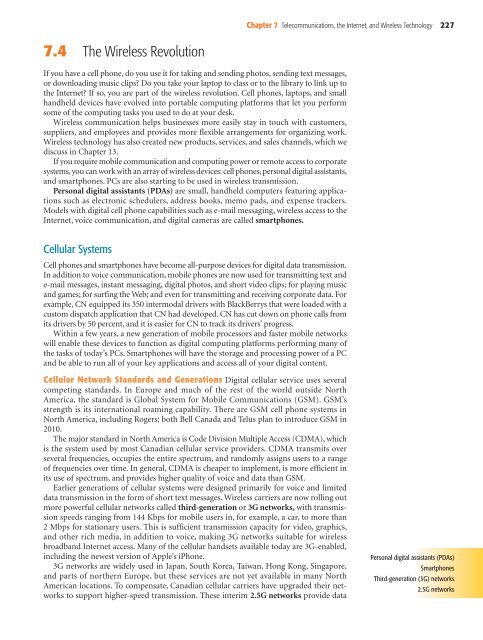Telecommunications, the Internet, and Wireless ... - Pearson Canada
Telecommunications, the Internet, and Wireless ... - Pearson Canada
Telecommunications, the Internet, and Wireless ... - Pearson Canada
Create successful ePaper yourself
Turn your PDF publications into a flip-book with our unique Google optimized e-Paper software.
Chapter 7 <strong>Telecommunications</strong>, <strong>the</strong> <strong>Internet</strong>, <strong>and</strong> <strong>Wireless</strong> Technology 227<br />
7.4 The <strong>Wireless</strong> Revolution<br />
If you have a cell phone, do you use it for taking <strong>and</strong> sending photos, sending text messages,<br />
or downloading music clips? Do you take your laptop to class or to <strong>the</strong> library to link up to<br />
<strong>the</strong> <strong>Internet</strong>? If so, you are part of <strong>the</strong> wireless revolution. Cell phones, laptops, <strong>and</strong> small<br />
h<strong>and</strong>held devices have evolved into portable computing platforms that let you perform<br />
some of <strong>the</strong> computing tasks you used to do at your desk.<br />
<strong>Wireless</strong> communication helps businesses more easily stay in touch with customers,<br />
suppliers, <strong>and</strong> employees <strong>and</strong> provides more flexible arrangements for organizing work.<br />
<strong>Wireless</strong> technology has also created new products, services, <strong>and</strong> sales channels, which we<br />
discuss in Chapter 13.<br />
If you require mobile communication <strong>and</strong> computing power or remote access to corporate<br />
systems, you can work with an array of wireless devices: cell phones, personal digital assistants,<br />
<strong>and</strong> smartphones. PCs are also starting to be used in wireless transmission.<br />
Personal digital assistants (PDAs) are small, h<strong>and</strong>held computers featuring applications<br />
such as electronic schedulers, address books, memo pads, <strong>and</strong> expense trackers.<br />
Models with digital cell phone capabilities such as e-mail messaging, wireless access to <strong>the</strong><br />
<strong>Internet</strong>, voice communication, <strong>and</strong> digital cameras are called smartphones.<br />
Cellular Systems<br />
Cell phones <strong>and</strong> smartphones have become all-purpose devices for digital data transmission.<br />
In addition to voice communication, mobile phones are now used for transmitting text <strong>and</strong><br />
e-mail messages, instant messaging, digital photos, <strong>and</strong> short video clips; for playing music<br />
<strong>and</strong> games; for surfing <strong>the</strong> Web; <strong>and</strong> even for transmitting <strong>and</strong> receiving corporate data. For<br />
example, CN equipped its 350 intermodal drivers with BlackBerrys that were loaded with a<br />
custom dispatch application that CN had developed. CN has cut down on phone calls from<br />
its drivers by 50 percent, <strong>and</strong> it is easier for CN to track its drivers’ progress.<br />
Within a few years, a new generation of mobile processors <strong>and</strong> faster mobile networks<br />
will enable <strong>the</strong>se devices to function as digital computing platforms performing many of<br />
<strong>the</strong> tasks of today’s PCs. Smartphones will have <strong>the</strong> storage <strong>and</strong> processing power of a PC<br />
<strong>and</strong> be able to run all of your key applications <strong>and</strong> access all of your digital content.<br />
Cellular Network St<strong>and</strong>ards <strong>and</strong> Generations Digital cellular service uses several<br />
competing st<strong>and</strong>ards. In Europe <strong>and</strong> much of <strong>the</strong> rest of <strong>the</strong> world outside North<br />
America, <strong>the</strong> st<strong>and</strong>ard is Global System for Mobile Communications (GSM). GSM’s<br />
strength is its international roaming capability. There are GSM cell phone systems in<br />
North America, including Rogers; both Bell <strong>Canada</strong> <strong>and</strong> Telus plan to introduce GSM in<br />
2010.<br />
The major st<strong>and</strong>ard in North America is Code Division Multiple Access (CDMA), which<br />
is <strong>the</strong> system used by most Canadian cellular service providers. CDMA transmits over<br />
several frequencies, occupies <strong>the</strong> entire spectrum, <strong>and</strong> r<strong>and</strong>omly assigns users to a range<br />
of frequencies over time. In general, CDMA is cheaper to implement, is more efficient in<br />
its use of spectrum, <strong>and</strong> provides higher quality of voice <strong>and</strong> data than GSM.<br />
Earlier generations of cellular systems were designed primarily for voice <strong>and</strong> limited<br />
data transmission in <strong>the</strong> form of short text messages. <strong>Wireless</strong> carriers are now rolling out<br />
more powerful cellular networks called third-generation or 3G networks, with transmission<br />
speeds ranging from 144 Kbps for mobile users in, for example, a car, to more than<br />
2 Mbps for stationary users. This is sufficient transmission capacity for video, graphics,<br />
<strong>and</strong> o<strong>the</strong>r rich media, in addition to voice, making 3G networks suitable for wireless<br />
broadb<strong>and</strong> <strong>Internet</strong> access. Many of <strong>the</strong> cellular h<strong>and</strong>sets available today are 3G-enabled,<br />
including <strong>the</strong> newest version of Apple’s iPhone.<br />
3G networks are widely used in Japan, South Korea, Taiwan, Hong Kong, Singapore,<br />
<strong>and</strong> parts of nor<strong>the</strong>rn Europe, but <strong>the</strong>se services are not yet available in many North<br />
American locations. To compensate, Canadian cellular carriers have upgraded <strong>the</strong>ir networks<br />
to support higher-speed transmission. These interim 2.5G networks provide data<br />
Personal digital assistants (PDAs)<br />
Smartphones<br />
Third-generation (3G) networks<br />
2.5G networks
















